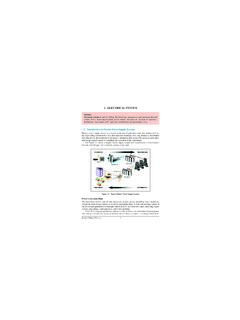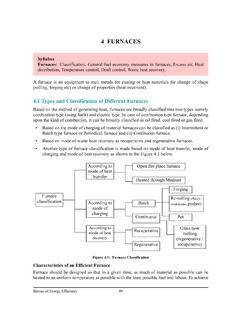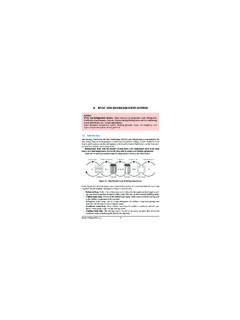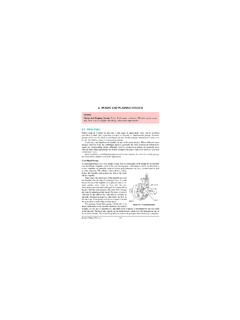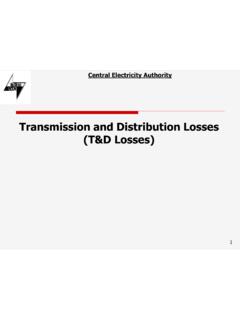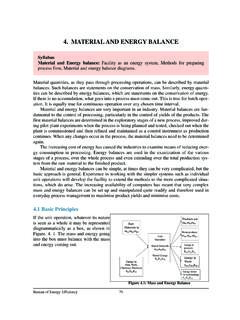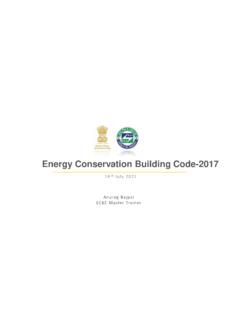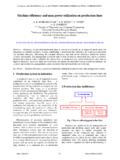Transcription of 2. BASICS OF ENERGYAND ITS VARIOUS FORMS
1 36 Bureau of Energy Efficiency2. BASICS OF ENERGY AND ITS VARIOUS FORMSS yllabusBasics of Energy and its VARIOUS FORMS : Electricity BASICS - DC & AC currents,Electricity tariff, Load management and Maximum demand control, Power factor. Thermal BASICS -Fuels, Thermal energy contents of fuel, Temperature & Pressure, Heatcapacity, Sensible and Latent heat, Evaporation, Condensation, Steam, Moist air andHumidity & Heat transfer, Units and is the ability to do work and work is the transfer of energy from one form to another. Inpractical terms, energy is what we use to manipulate the world around us, whether by excitingour muscles, by using electricity, or by using mechanical devices such as automobiles. Energycomes in different FORMS - heat (thermal), light (radiant), mechanical, electrical, chemical, andnuclear FORMS of EnergyThere are two types of energy - stored (potential) energy and working (kinetic) energy.
2 Forexample, the food we eat contains chemical energy, and our body stores this energy until werelease it when we work or Potential EnergyPotential energy is stored energy and the energy of position (gravitational). It exists in EnergyChemical energy is the energy stored in the bonds of atoms and molecules. Biomass, petrole-um, natural gas, propane and coal are examples of stored chemical EnergyNuclear energy is the energy stored in the nucleus of an atom - the energy that holds the nucle-us together. The nucleus of a uranium atom is an example of nuclear Mechanical EnergyStored mechanical energy is energy stored in objects by the application of a force. Compressedsprings and stretched rubber bands are examples of stored mechanical energy. 2. BASICS of Energy and its VARIOUS Forms37 Bureau of Energy EfficiencyGravitational EnergyGravitational energy is the energy of place or position.
3 Water in a reservoir behind a hydropow-er dam is an example of gravitational energy. When the water is released to spin the turbines, itbecomes motion Kinetic Energy Kinetic energy is energy in motion- the motion of waves, electrons, atoms, molecules and sub-stances. It exists in VARIOUS EnergyRadiant energy is electromagnetic energy that travels in transverse waves. Radiant energyincludes visible light, x-rays, gamma rays and radio waves. Solar energy is an example of radi-ant EnergyThermal energy (or heat) is the internal energy in substances- the vibration and movement ofatoms and molecules within substances. Geothermal energy is an example of thermal movement of objects or substances from one place to another is motion. Wind andhydropower are examples of is the movement of energy through substances in longitudinal (compression/rarefaction) EnergyElectrical energy is the movement of electrons.
4 Lightning and electricity are examples of elec-trical Energy ConversionEnergy is defined as "the ability to do work." In this sense, examples of work include movingsomething, lifting something, warming something, or lighting something. The following is anexample of the transformation of different types of energy into heat and is difficult to imagine spending an entire day without using energy. We use energy to light ourcities and homes, to power machinery in factories, cook our food, play music, and operate the number of conversion stages, lesserthe overall energy efficiencyOil burns to generate heat --> Heat boils water -->Water turns to steam -->Steam pressure turns a turbine -->Turbine turns an electric generator -->Generator produces electricity -->Electricity powers light bulbs -->Light bulbs give off light and heat2.
5 BASICS of Energy and its VARIOUS Forms38 Bureau of Energy Grades of EnergyHigh-Grade EnergyElectrical and chemical energy are high-grade energy, because the energy is concentrated in asmall space. Even a small amount of electrical and chemical energy can do a great amount ofwork. The molecules or particles that store these FORMS of energy are highly ordered and com-pact and thus considered as high grade energy. High-grade energy like electricity is better usedfor high grade applications like melting of metals rather than simply heating of EnergyHeat is low-grade energy. Heat can still be used to do work (example of a heater boiling water),but it rapidly dissipates. The molecules, in which this kind of energy is stored (air and watermolecules), are more randomly distributed than the molecules of carbon in a coal.
6 This disor-dered state of the molecules and the dissipated energy are classified as low-grade energy. Electrical Energy BasicsElectric current is divided into two types: Directional Current (DC) and Alternating Current(AC).Directional (Direct) CurrentA non-varying, unidirectional electric current (Example: Current produced by batteries)Characteristics: Direction of the flow of positive and negative charges does not change with time Direction of current (direction of flow for positive charges) is constant with time Potential difference (voltage) between two points of the circuit does not change polaritywith timeAlternating CurrentA current which reverses in regularly recurring intervals of time and which has alternately pos-itive and negative values, and occurring a specified number of times per second.
7 (Example:Household electricity produced by generators, Electricity supplied by utilities.)Characteristics: Direction of the current reverses periodically with time Voltage (tension) between two points of the circuit changes polarity with time. In 50 cycle AC, current reverses direction 100 times a second (two times during onecycle)Ampere (A) Current is the rate of flow of charge. The ampere is the basic unit of electric current. It is thatcurrent which produces a specified force between two parallel wires, which are 1 metre apartin a (V)The volt is the International System of Units (SI) measure of electric potential or electromo-2. BASICS of Energy and its VARIOUS Forms39 Bureau of Energy EfficiencykVAr (Reactive Power)kVAr is the reactive power. Reactive power is the portion of apparent power that does no type of power must be supplied to all types of magnetic equipment, such as motors, trans-formers etc.
8 Larger the magnetizing requirement, larger the (kW) (Active Power)kW is the active power or the work-producing part of apparent force. A potential of one volt appears across a resistance of one ohm when a current of oneampere flows through that V = 1 kiloVolts (kV)ResistanceVoltageResistance = _____CurrentThe unit of resistance is ohm ( )Ohm' LawOhm's law states that the current through a conductor is directly proportional to the potentialdifference across it, provided the temperature and other external conditions remain The supply frequency tells us the cycles at which alternating current changes. The unit of fre-quency is hertz (Hz :cycles per second).Kilovolt Ampere (kVA)It is the product of kilovolts and amperes. This measures the electrical load on a circuit or sys-tem. It is also called the apparent power.
9 1000 AmperesxVoltage(kVA)powerApparent,circui t electrical phase single aFor =1000)(,sinfactorPowerxAmperesxVoltagekW PowerphasegleFor= )(,factorPowerxAmperesxVoltagexkWPowerph aseThreeFor=1000 AmperesxVoltagex3(kVA)powerApparent,circ uit electrical phase threeaFor =2. BASICS of Energy and its VARIOUS Forms40 Bureau of Energy EfficiencyPower FactorPower Factor (PF) is the ratio between the active power (kW) and apparent power (kVA).When current lags the voltage like in inductive loads, it is called lagging power factor and whencurrent leads the voltage like in capacitive loads, it is called leading power factor. Inductive loads such as induction motors, transformers, discharge lamp, etc. absorb com-paratively more lagging reactive power (kVAr) and hence, their power factor is poor.
10 Lower thepower factor; electrical network is loaded with more current. It would be advisable to havehighest power factor (close to 1) so that network carries only active power which does realwork. PF improvement is done by installing capacitors near the load centers, which improvepower factor from the point of installation back to the generating (kWh)Kilowatt-hour is the energy consumed by 1000 Watts in one hour. If 1kW (1000 watts) of a elec-trical equipment is operated for 1 hour, it would consume 1 kWh of energy (1 unit of electrici-ty).For a company, it is the amount of electrical units in kWh recorded in the plant over a monthfor billing purpose. The company is charged / billed based on kWh TariffCalculation of electric bill for a companyElectrical utility or power supplying companies charge industrial customers not only based onthe amount of energy used (kWh) but also on the peak demand (kVA) for each DemandContract demand is the amount of electric power that a customer demands from utility in a spec-ified interval.
